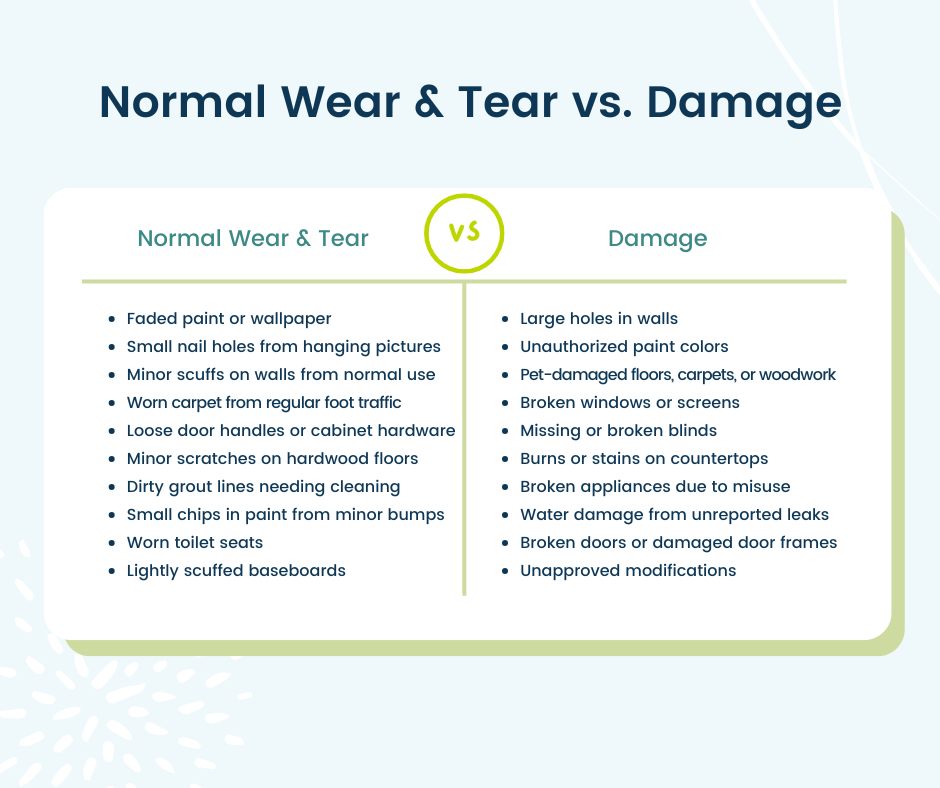Normal Wear and Tear vs. Damage
Normal wear and tear include the natural deterioration that occurs through everyday living, such as worn carpets in high-traffic areas or faded paint on walls. Damage, however, encompasses issues beyond regular use, such as broken windows, large holes in walls, or appliances broken through misuse. This distinction is crucial because it determines who bears the financial responsibility for repairs. While specific requirements may vary by location and lease terms, understanding these fundamental differences helps landlords and tenants navigate their repair responsibilities effectively and maintain a positive rental relationship.
Legal Obligations
Before a tenant moves in, it’s the landlord’s responsibility to ensure the property is in good repair and meets basic habitability standards. In Colorado, for example, the warranty of habitability protects tenant rights by requiring landlords to provide functioning plumbing, hot water, and heating systems, weatherproofing, pest-free living spaces, and proper security measures, among other essential requirements. Documenting the property's condition through a detailed move-in inspection is crucial, as it establishes a baseline for its condition. Without this documentation, disputes may arise later about whether existing damage occurred during the tenant's occupancy or was present before they moved in. This initial assessment protects both parties and helps delineate future repair responsibilities.Rental Property Obligations: Know Your Role
Landlords: Landlords have fundamental obligations that form the cornerstone of the rental agreement. At the most basic level, they must provide and maintain essential services such as functioning plumbing, heating, and electrical systems. These services aren't just conveniences – they're legal requirements that ensure the property meets safety standards and remains habitable. Landlords must also maintain the structural integrity of the building, ensure proper weatherization, and address any safety hazards promptly. This includes maintaining smoke detectors, carbon monoxide detectors, secure locks, and ensuring the property meets all local building codes. Keeping the property in good condition extends beyond just responding to problems; it involves regular maintenance and inspections to prevent issues before they become serious concerns. Tenants: On the tenant side, responsibilities center around proper use and care of the property. While normal wear and tear is expected and permitted, tenants must avoid causing damage beyond this reasonable use. This means properly using appliances and fixtures, maintaining cleanliness, and avoiding activities that could harm the property. One of the most critical tenant responsibilities is promptly reporting maintenance issues or needed repairs to the landlord. Delays in reporting problems can lead to more extensive damage, potentially shifting liability to the tenant if their failure to report results in additional damage.
Proper maintenance includes regular cleaning, changing air filters, keeping the property free from pests through good housekeeping practices, and following any specific maintenance requirements outlined in the lease agreement. By understanding and fulfilling these basic responsibilities, landlords and tenants can maintain a functional and positive rental relationship while preserving the property's condition.
This means properly using appliances and fixtures, maintaining cleanliness, and avoiding activities that could harm the property. One of the most critical tenant responsibilities is promptly reporting maintenance issues or needed repairs to the landlord. Delays in reporting problems can lead to more extensive damage, potentially shifting liability to the tenant if their failure to report results in additional damage.
Proper maintenance includes regular cleaning, changing air filters, keeping the property free from pests through good housekeeping practices, and following any specific maintenance requirements outlined in the lease agreement. By understanding and fulfilling these basic responsibilities, landlords and tenants can maintain a functional and positive rental relationship while preserving the property's condition.
Types of Repairs: Understanding Financial Responsibility
Understanding different types of repairs and who is responsible for paying the cost of repairs is crucial for both landlords and tenants. Clarity about repair responsibilities helps prevent disputes, ensures prompt maintenance, and protects both parties' financial interests. It also helps maintain the property's value while ensuring a safe and comfortable living environment for tenants. Emergency repairs require immediate attention as they pose safety, health, or significant property damage risks. These include burst water pipes, gas leaks, complete heating system failure in winter, or electrical hazards. Depending on local laws, landlords must respond to these situations promptly, typically within 24-48 hours. While landlords are generally responsible for emergency repair costs, tenants might need to arrange and pay for immediate repairs if the landlord is unreachable, with the right to seek reimbursement later. Major repairs involve significant work on essential components of the property. These include structural repairs like roof replacement, foundation issues, or major plumbing system overhauls. Essential systems such as HVAC units, water heaters, or electrical panels also fall into this category. The cost considerations for major repairs typically fall to the landlord, as these involve maintaining the property's basic functionality and value. However, if tenant negligence caused the need for major repairs, the financial responsibility may shift to the tenant. Minor repairs encompass the small, routine maintenance issues during normal occupancy. Examples include dripping faucets, stuck windows, or minor appliance issues. Typically, the lease agreement outlines responsibilities for minor repairs, but landlords generally handle these unless the damage results from tenant misuse. Cost allocation for minor repairs often depends on the cause: if it's normal wear and tear, the landlord pays; if it's due to tenant damage, the tenant bears the cost.The Repair Process: Steps to Successful Resolution
A clear, well-documented repair process protects landlords and tenants while ensuring necessary repairs are completed in a reasonable amount of time. Following proper procedures helps maintain the property's condition, prevents misunderstandings, preserves legal rights, and creates a clear record of actions taken by both parties.
When Disputes Arise: Resolving Rental Repair Conflicts
 Disagreements about repairs between landlords and tenants often stem from three main areas of contention. Cost responsibility disputes frequently arise when there's uncertainty about whether the damage resulted from normal wear and tear or tenant negligence. Quality of repairs can become contentious when tenants feel work was done inadequately or with subpar materials, while landlords maintain the repairs meet acceptable standards. Timeliness issues often create friction when repairs take longer than expected or when there's disagreement about a reasonable response time.
When informal resolution attempts fail, tenants have several legal remedies available, though these should be pursued carefully per local laws. Rent withholding, or nonpayment of rent where tenants legally withhold rent until repairs are completed, requires strict adherence to state laws and proper documentation. Some jurisdictions permit "repair and deduct" remedies, allowing tenants to arrange and pay for repairs themselves and then deduct the cost from their rent. However, this option typically requires advance notice to the landlord and precise documentation. When other methods fail, small claims court or in some instances, housing court provides a venue for resolving disputes over repair costs or deposit deductions, though it should generally be considered a last resort.
Security deposits often become the focal point of repair disputes at the end of the lease. Landlords may withhold deposit funds to cover repair costs they believe are the tenant's responsibility, while tenants might dispute these deductions. To protect both parties, detailed documentation of the property's condition at move-in and move-out is essential, along with clear records of all repair requests, responses, and completed work. Understanding that security deposit deductions must be itemized and supported by evidence can help prevent or resolve disputes over repair-related charges.
Disagreements about repairs between landlords and tenants often stem from three main areas of contention. Cost responsibility disputes frequently arise when there's uncertainty about whether the damage resulted from normal wear and tear or tenant negligence. Quality of repairs can become contentious when tenants feel work was done inadequately or with subpar materials, while landlords maintain the repairs meet acceptable standards. Timeliness issues often create friction when repairs take longer than expected or when there's disagreement about a reasonable response time.
When informal resolution attempts fail, tenants have several legal remedies available, though these should be pursued carefully per local laws. Rent withholding, or nonpayment of rent where tenants legally withhold rent until repairs are completed, requires strict adherence to state laws and proper documentation. Some jurisdictions permit "repair and deduct" remedies, allowing tenants to arrange and pay for repairs themselves and then deduct the cost from their rent. However, this option typically requires advance notice to the landlord and precise documentation. When other methods fail, small claims court or in some instances, housing court provides a venue for resolving disputes over repair costs or deposit deductions, though it should generally be considered a last resort.
Security deposits often become the focal point of repair disputes at the end of the lease. Landlords may withhold deposit funds to cover repair costs they believe are the tenant's responsibility, while tenants might dispute these deductions. To protect both parties, detailed documentation of the property's condition at move-in and move-out is essential, along with clear records of all repair requests, responses, and completed work. Understanding that security deposit deductions must be itemized and supported by evidence can help prevent or resolve disputes over repair-related charges.

